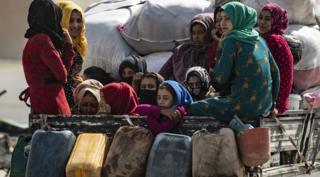Home » Middle East »
The people caught in the middle in northern Syria
Tens of thousands of civilians have been forced to flee fighting in northern Syria and are in desperate need of humanitarian assistance, the UN has said.
Turkey launched a cross-border military operation against Kurdish-led forces in the region last week, days after previously allied US troops pulled back from the border. Dozens of civilians and fighters have since been killed.
With the Syrian government now sending troops to border to try to halt the Turkish offensive and US troops ordered to withdraw, humanitarian organisations fear for the safety of people trapped in the conflict zone.
What’s the situation like for ordinary people?
Thousands are on the move
The Turkish operation – aimed at pushing a Kurdish militia that the Turkish government considers a terrorist group away from the border area and creating a “safe zone” where Syrian refugees can be resettled – has involved air strikes, artillery and ground attacks on targets across the region.
Civilians have been killed on both sides of the border.
France’s President, Emmanuel Macron, said the offensive risked creating an “unbearable humanitarian situation”.
At least 150,000 civilians had fled their homes by Sunday, the UN Office for the Co-ordination of Humanitarian Affairs (OCHA) said. And up to 400,000 may need help in the coming days and weeks.
UN Secretary General António Guterres has demanded “sustained, unimpeded and safe humanitarian access to civilians in need” to allow the organisation and its humanitarian partners to carry out their work.
Some 1.5 million people were already in need of health aid before the offensive, the World Health Organization said.
“We are trying to reach as many people as possible and are despatching emergency food packages as tens of thousands are fleeing their areas every day,” said Corinne Fleischer, the WFP’s country director in Syria.
Most people have fled the border towns of Ras al-Ain and Tal Abyad, according to the OCHA, but others have left nearby camps set up for people already displaced by the Syrian civil war and the battle against the Islamic State (IS) group.
On Sunday, artillery shells hit several areas close to two camps at Ain Issa, which had been home to 13,000 displaced people, the OCHA said.
An “unspecified number of people” have now fled the camp.
Most of those fleeing have sought shelter with relatives, friends or with local communities. Others have headed for a number of “collective shelters” across the region, where people are offered help before moving onto more secure accommodation.
The UN also oversaw the evacuation of Mabruka camp, close to the Turkish border, moving its 5,000 residents to Areesheh, to the south, after mortars struck the surrounding area on Thursday.
Relatives of IS fighters have also fled
Before the Turkish offensive, tens of thousands of relatives of suspected IS militants were being detained by Kurdish-led forces at Ain Issa and two other camps in northern Syria – al-Hol and Roj.
The UN has expressed “serious concern” that the ongoing military action could lead to the “unintended release of individuals” associated with IS.
Kurdish officials said the shelling of the area around the Ain Issa camps led to the escape of almost 800 relatives of IS members over the weekend. However, the Syrian Observatory for Human Rights, a UK-based monitoring group, said the number of people who fled was 100. It not known where they have gone.
Some 12,000 men suspected of being IS militants – Syrians, Iraqis and other foreigners – are being held at seven prisons run by Kurdish-led forces.
Hospitals and infrastructure have been damaged
A number of hospitals and clinics in northern Syrian towns have closed as a result of the violence.
The national hospital in Ras al-Ain, as well as the national hospital and two health centres in Tal Abyad, are out of action, according to the WHO.
Field hospitals at some camps have also had their medical services affected.
A shortage of health workers – themselves displaced by the conflict – has made the situation worse, the WHO says.
Some of the affected areas are also reporting shortages of food, water and electricity.
Damage to a water pumping station in Ras al-Ain, the main water source for most of Hassakeh province, has increased the risk of outbreaks of infectious diseases.
Source: Read Full Article



